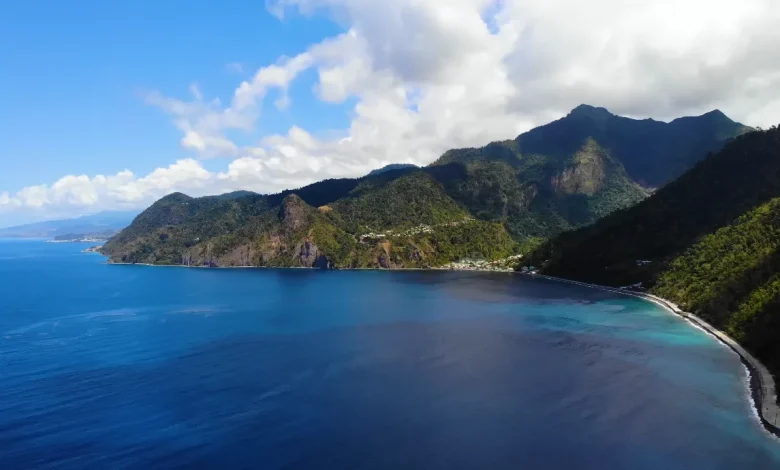Coastal Communities in Dominica

Coastal communities in Dominica play a central role in the island’s economic activity, cultural life, and environmental connectivity. While Dominica’s mountain villages and interior settlements offer seclusion, biodiversity, and traditional farming, the coastal areas serve as gateways for trade, tourism, fisheries, and inter-island transportation. These communities have historically developed as fishing villages, but today, many also support eco-tourism and marine conservation, serving as centers for commerce and government.
Their geographic location along the Caribbean Sea and Atlantic Ocean makes them more vulnerable to hurricanes and coastal erosion, yet they remain vital for food security and cultural resilience. Compared to interior villages, coastal communities are often more accessible and integrated into the national infrastructure—hosting ports, airports, and tourism hubs.
Key Coastal Towns and Economic Hubs
These communities are the engine rooms of Dominica’s coastal economy, offering a mix of commerce, tourism, governance, and maritime services vital to national development.
1. Roseau
Dominica’s capital blends colonial architecture, lively markets, and modern governance. As the island’s commercial and administrative center, Roseau connects visitors to nature sites, sea excursions, and national infrastructure.
- Role: Capital city and main port
- Highlights: Government offices, markets, cruise ship berth, French colonial architecture
- Significance: Dominica’s cultural, political, and economic heart
2. Portsmouth
Located on Prince Rupert Bay, Portsmouth is Dominica’s northern hub for commerce, fishing, and tourism. It hosts bustling markets, historic Fort Shirley, and serves as a base for marine activities.
- Role: Second-largest town, northern commercial center
- Highlights: Prince Rupert Bay, Cabrits National Park, Fort Shirley
- Significance: Tourism, market trading, and fishing
Traditional Fishing Villages and Cultural Centers
These coastal communities reflect Dominica’s maritime heritage, where fishing, culture, and natural beauty converge to sustain traditional livelihoods and inspire vibrant community life.
3. Scott’s Head
This southern coastal village offers dramatic ocean views where the Atlantic Ocean meets the Caribbean Sea. Known for its marine reserve and volcanic headland, it’s a hotspot for snorkelling and local fishing.
- Location: Southernmost point of Dominica
- Highlights: Marine Reserve, scuba diving spots, dramatic headland views
- Significance: Important historical fishing village and tourism hotspot
4. Soufrière
Surrounded by coral reefs and sulphur springs, Soufrière thrives as a quiet fishing community and diving destination. It blends cultural authenticity with marine biodiversity in Dominica’s southwest corridor.
- Location: Southwestern coast
- Highlights: Coral reefs, sulphur springs, marine biodiversity
- Significance: Base for snorkeling, community tourism
5. Calibishie
With red cliffs, palm-lined beaches, and artisan culture, Calibishie is a peaceful village on the north coast. It offers eco-lodging, fishing traditions, and dramatic coastal scenery.
- Location: Northern coast
- Highlights: Red Rocks, beaches, artisanal products
- Significance: Fishing and boutique eco-tourism destination
Transportation Gateways and Growing Settlements
Strategically located, these areas connect Dominica to the outside world, serving as vital entry points and growing towns that blend convenience, commerce, and coastal charm.
6. Marigot
Home to Douglas-Charles Airport, Marigot serves as a key transport hub on the northeast coast. It combines small-village character with lush surroundings and essential access for international visitors.
- Location: Northeastern coast
- Highlights: Near Douglas-Charles Airport
- Significance: Primary entry point for international travelers
7. Castle Bruce
The island’s largest east coast village, Castle Bruce borders untouched beaches and rolling hills. Its residents preserve agricultural traditions while supporting sustainable tourism and forest trail access inland.
- Location: East coast
- Highlights: Untouched beaches, gateway to the interior
- Significance: Agricultural base and cultural heritage site
Cultural and Residential Communities
More than scenic villages, these coastal settlements are rich with tradition, artistry, and daily life, offering insight into Dominica’s evolving identity and social fabric.
8. Grand Bay (Berekua)
A cultural stronghold in the south, Grand Bay is known for its vibrant music, resistance history, and Creole festivals. It’s a proud center of grassroots activism and artistry.
- Location: South coast
- Highlights: Vibrant Creole culture, festivals
- Significance: Known for its music, dance, and resistance heritage
9. La Plaine
Surrounded by rivers and rainforest, La Plaine connects nature and community. It promotes eco-tourism and wellness retreats while remaining deeply rooted in traditional livelihoods and environmental awareness.
- Location: Southeast
- Highlights: River valleys, eco-lodges, waterfalls
- Significance: Environmental conservation and eco-tourism
10. Mahaut
Just north of Roseau, Mahaut balances residential life with coastal access and small businesses. It’s a growing settlement offering quiet charm and proximity to the island’s capital amenities.
- Location: West coast near Roseau
- Highlights: Residential zone, scenic views
- Significance: Growing housing community and light commerce
11. Salisbury (Barroui)
Positioned along the scenic west coast, Salisbury supports both fishing and farming. It’s a quiet community known for birdwatching, coastal beauty, and access to hiking routes inland.
- Location: Central west coast
- Highlights: Birdwatching, natural beauty
- Significance: Combines traditional village life with eco-tourism access
The Broader Importance
Dominica’s coastal communities provide critical support to marine conservation, food supply chains, and disaster preparedness. These settlements complement the island’s interior farming villages by facilitating export logistics, market access, and tourist engagement.
They also serve as custodians of seafaring traditions, culinary heritage, and creole identity, often overlooked in mountain settlements. Together with the interior communities, they form an essential balance in Dominica’s cultural and environmental landscape—where sea and land meet to shape the nation’s livelihood.




